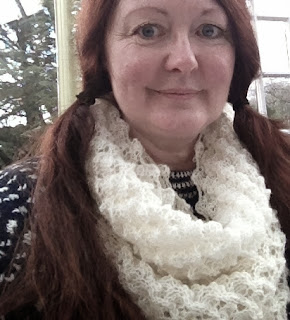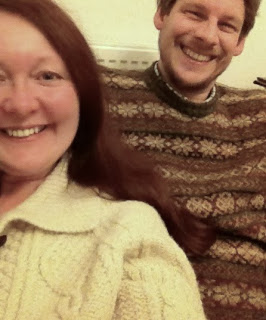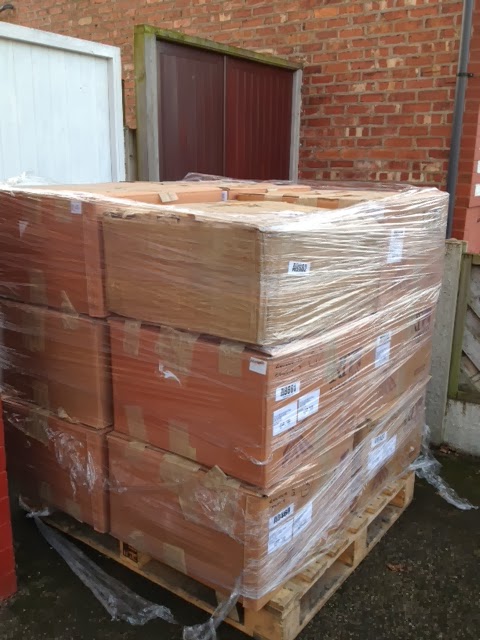I had a lot of fun over the Christmas holidays wearing knitwear every day - something which I've come to realise I do most of the time anyway without even thinking about it - and recording it on Instagram. So I thought to get the blog up and running for 2014 I would share with you some of the knits I wore. The photos are on the low quality side I'm afraid as I managed to forget to save the originals in my enthusiasm but nontheless I think they really show how your vintage handknits can be integral to your every day wardrobe. Some of the knits I made myself and others are vintage finds or even new knits purchased!

This first cardigan I bought about three years ago from Andersons of Lerwick. It is knitted in pure Shetland wool and is the quintessential round neck, yoked cardigan which has become synonomous with shetland knits of the 1960s. The cardigan is hand framed and then hand finished by the ladies who work at Andersons. Its one of my most favourite cardigans in the world and I must wear it at least once every week during the winter. Interestingly this garment is seamed as you can see on the yoke.
This second cardigan is my other go-to cardigan. This is the Bubble Stitch Yoke cardigan from
A Stitch in Time volume 2. It has a very 1950s feel to it yet was created in the 1940s when the fashions of the period where on the cusp of change. War was over and materials were becoming more easily available hence the longer length sleeves and hip length of the body. Also note the high neck and ample buttons. My version is knitted in
Excelana 4 ply in Saharan Sand. I can't tell you how many times I've worn this cardigan but it is a lot! What is particularly lovely about it is that mum knitted the lower parts of the body that didn't have any shaping or buttonholes and then my mother in law and I took over and finished it.
This jumper was my find of the year in 2012. A hand knit vintage Icelandic lopi knitted in a typically chunky but light lopi yarn in natural colours with this beautiful stylised leaf pattern on the yoke. It is knitted in one piece and is completely seamless. This jumper has a longer line finishing mid thigh. It is quite fitted which I prefer to oversized as 1) it still fits under a jacket and 2) it doesn't make me feel like Michelin woman. A simplified version of the yoke pattern is repeated just above the welt and cuffs. It is a very warm jumper so I tend to save it for outdoors but worn inside it does mean I can leave the heating off!
Another favourite from a
Stitch in Time volume 2 now. This is Lady Georgiana's Jumper. It is knitted in
Excelana DK and I've used French Rose here. The v neck and lace panels on both sleeves, front and back stop the jumper from being overly hot indoors and is a really easy knit to wear. Double knit weight yarn and all over single rib did have me worried that I could look a little 'bulky' in this jumper but actually it is a really flattering jumper.
I was lucky enough this year to have a very lazy Christmas Day. Our daughter, Charlie very kindly made Christmas dinner and I was repeatedly told to go and sit down and chill. As you can see from this photo I didn't even do my hair but felt extremely relaxed in my
Agutter cardigan, again knitted in
Excelana DK but this time using Persian Grey. This cardigan is probably the most casual garment I have designed although equally it can look really smart with a 1980s collared dress underneath. For this occasion I wore it with a silky long sleeved jersey top underneath and my 1930s style wide legged palazzo pants - or my eating pants as I fondly call them. As they are very generously shaped they allow for huge numbers of roast potatoes to be eaten in any one sitting! The cardigan is knitted in separate flat pieces and seamed. For this longer line of slightly oversized garment I feel the side seams in particular help it keep its shape and stop it from dropping.
These two photos show me wearing the original Ena Sweater from
A Stitch in Time volume 1. It is knitted in
Jamieson & Smith 2 ply jumper weight Shetland wool and even 5 years of being used as a display garment or being worn, it looks like new. It was the very first garment I knitted for the Stitch in Time books so has a very special place in my heart. Again it has that marvellous balance of smart yet casual and effortless comfort that you want from knitwear. I also like and need my knits to have longevity and this garment is the perfect example of this. The vintage beads also appeared with this jumper in the photoshoot for this garment.

These two photos show both a vintage and a new piece combined. I bought this genuine Norwegian lice jumper about a year ago at a vintage sale for about £10 - an absolute bargain. It has slightly dropped shoulders but just about right for a garment of its bulk so that I can wear one or two lighter weight layers underneath. It is again pure wool and did need a little bit of a condition when I first bought it. I'll tell you more about how I rejuvinate my vintage knits in a week or two. Initially I did buy this for Gavin but its my jumper now!

And worn with my vintage jumper is a design I've been toying with for some time. Inspired by 1940s patterns, themselves inspired by Spanish Mantillas, this cowl is so light you barely notice you are wearing it. It is knitted in Fenella, my new 2 ply knits as 3 ply, 100% pure new British wool using a wonderfully 'frothy' lace stitch which I've used once before several years ago to make a curtain and I've always wanted to use it again for a scarf or cowl. Both Fenella and the kit for the cowl will be available in just a couple of weeks time but I'll tell you more about that very soon.
Another old favourite is this cardigan from
A Stitch in Time volume 1 - The Diagonal Rib Cardigan - my version is knitted in
Excelana DK using Cornflower Blue. The original pattern has 7 or 8 buttons with buttonholes up to just below the collar bone. However I have found that my body shape doesn't suit the buttons stopping at this point. It seems to maximise my chest - and frankly it doesn't need much help in that area - so I only have the 4 buttonholes that you can see on my version. When these 4 buttons are all done up they help create a bit of an hour glass silhouette. I think button placement - particularly for those of us with more for the buttons to contain - is a vital part of customising a hand made garment to fit and suit you perfectly and this is another topic I'll be talking about on the blog this year.
Not the most flattering photos of me unfortunately, but here I am about to go out on New Year's eve in my Swagger Coat from
A Stitch in Time volume 2. Gavin and I had been playing a wee drinking game involving Baileys Irish Cream and Game of Thrones before walking round to my in laws - I think you can probably see we were enjoying the game in my rosy cheeks. My Swagger Coat - or Miss Marple's coat as worn by Geraldine McKeown - is knitted in
Fyberspates Scrumptious Aran weight. The coat has held its shape really well even though I have grown a little in the two years since I knitted it.
Here's a little detail of the vintage 1930s buttons I used for the fabulous cross over neck fastening. The pattern explains the correct way for fastening these and I'm sad to say that Miss Marple didn't read the pattern and is usually seen with her Swagger Coat buttoned up incorrectly.

Yet another vintage yoked jumper. I absolutely love them and have quite a few now. This one is an early 60s model, interestingly knitted completely in the round this time. It has the hallmark high neck of the period and you might be surprised to hear that is extremely comfy to wear. The ribbing at the neck is turned over creating a nice stretchy top edge to the neckband and no raw edges to irritate either. I have seen tighter, closer necks than this one though so be careful and check it will go over your head before you buy. If you can't resist buying even though the neck is tight or if you've bought off somewhere like ebay, I'll be sharing a tutorial on the blog showing how to lower the neckline and create a new neckband. The colours of the yoke are quite acidic and ordinarily aren't the tones I would normally go for but combined with the very dark brown background colour and the natural Moorit shade of the main body, the overall effect is spot on.

And finally, a post New Year photo for you of Gavin and me in our comfiest of comfy knits. Gavin is wearing his genuine Shetland jumper purchased at the Spider's Web in Lerwick on Shetland. Knitted in Shetland wool in autumnal shades of greens, golds and plums it is truly beautiful, warm and robust. I'm wearing my 1950s aran cardigan which I must wear almost every day. It still has its leather shank buttons and never shows any sign of wear. A lot of the cardigans of this style that you find in vintage shops are replicas and/or made of acrylic yarns from the late 70s, early 1980s. There would appear to be no difference in price if you manage to find a wool one, so I would suggest do so if you can. It will probably still be around well after us. You can also condition wool to make it softer again, not something you can do with acrylic yarns. If you can't get one with leather buttons these are pretty easy to come by usually in mixed bags of random buttons in baskets in vintage shops. Buy them too and use them to replace the buttons on your aran cardigan.
And there you have it. My holiday in knit wear!
I'll be back very soon but
for now
Ruby xx























